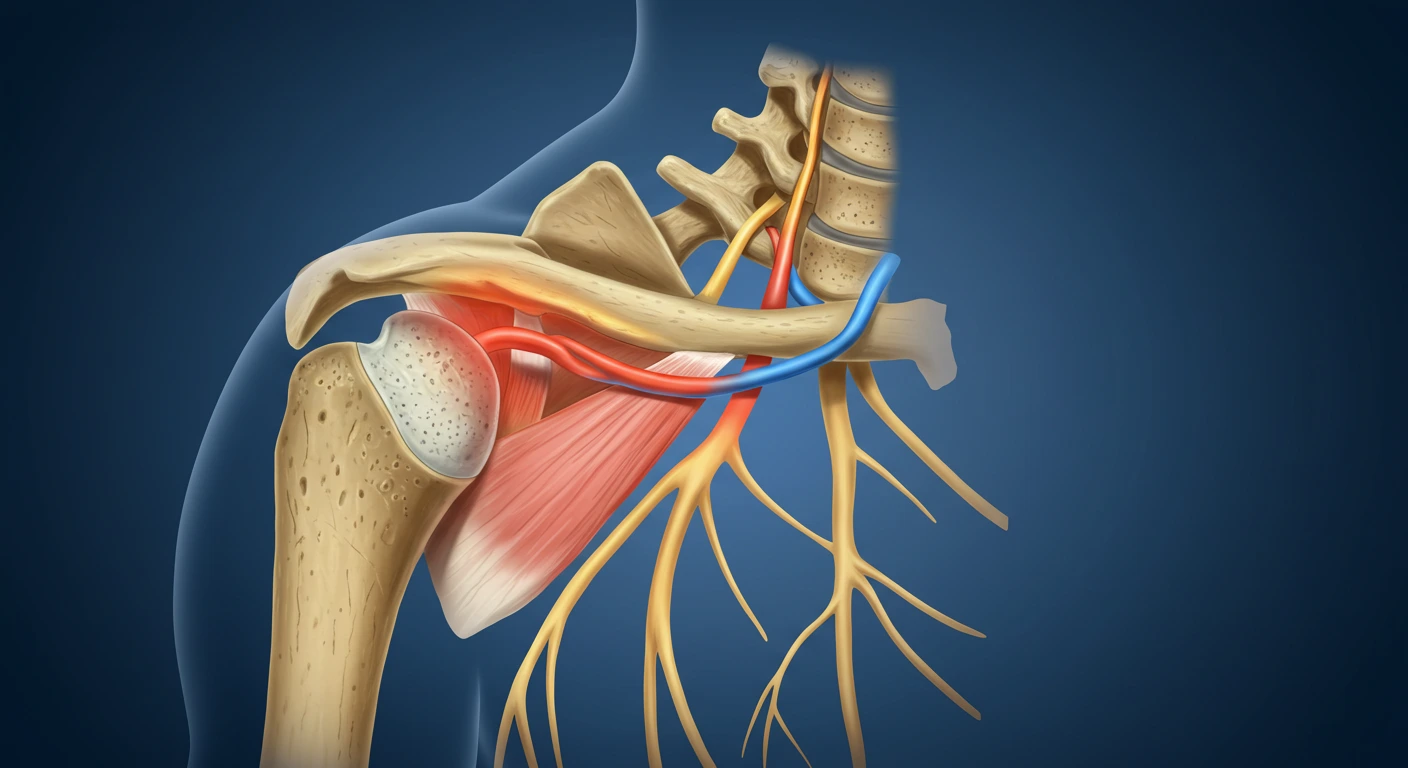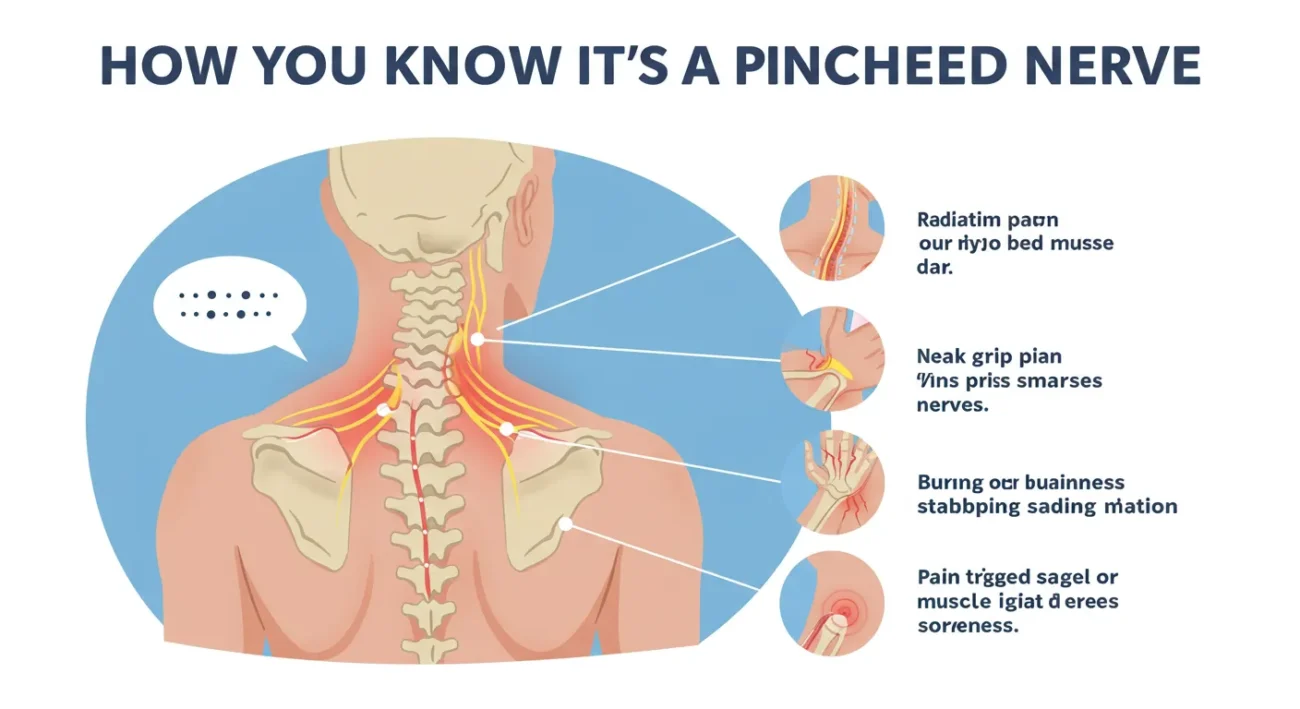How to Release a Pinched Nerve in the Shoulder Blade

Have you ever felt that nagging ache, numbness, or pins and needles under your shoulder blade that just won’t quit, A pinched nerve in the shoulder blade area can make even small movements miserable. Maybe you slept funny, lifted something awkwardly, or just sat hunched over your phone all day and now it hurts. Good news you’re not alone, and there are things you can do that help gently, safely, without rushing into anything drastic.
I’ll walk you through how to release a pinched nerve in the shoulder blade what causes it, how to tell if it’s really a pinched nerve, home remedies, stretches and exercises, when to get help, and how to prevent it from coming back.
What Is a “Pinched Nerve” Under the Shoulder Blade
When people say “pinched nerve in the shoulder blade,” they usually mean a nerve being compressed or irritated somewhere along its path, often starting in the neck (cervical spine) then traveling through muscles and connective tissue near or under the shoulder blade (scapula). The compression may happen at several places:
- In the neck between vertebrae (for example, a herniated disc or bone spur pressing on the nerve root).
- As the nerve passes through tight muscles (e.g., under the trapezius, levator scapulae, rhomboids).
- In “neurovascular” passageways under the shoulder blade (rare, but possible) where muscular tension, inflammation, or postural issues limit space.
Nerve roots commonly involved are from C4, C5, C6 depending on whether pain/numbness is felt under the shoulder blade, spreading toward the arm, etc.
How You Know It’s a Pinched Nerve

It’s important to distinguish a pinched nerve from general muscle soreness. Here are signs pointing more toward a nerve issue:
- Pain that radiates (e.g. under shoulder blade, toward the arm, neck)
- Numbness or tingling (“pins & needles”) in shoulder blade, arm, fingers
- Weakness in arm, hand or in specific motions (e.g. difficulty lifting something, or gripping)
- Sharp, stabbing pains, or burning sensations, sometimes worse with certain neck positions
- Aggravation by things like turning head, looking up, or overhead reaching
If it’s just a muscle, pain tends to stay localized, dull, and improves with simple rest and nuru massage. If the above nerve signs are there, that tells you more serious attention is needed.
Gentle First Aid You Can Try Right
You don’t need to rush to intense therapy. Start with these gentle methods. If they’re done carefully, they often help a lot.
Rest & Modify Activities
- Avoid lifting heavy things, overhead work, or movements that make the pain worse.
- Don’t stay in one position too long sitting hunched over, slumped, tilted head these tend to stress the area.
Cold & Heat Therapy
- Apply cold (ice pack wrapped in cloth) to the shoulder blade and side of the neck for 15-20 minutes during the first 48 hours (if swelling or recent injury). Cold helps reduce inflammation.
- After about 2 days, switch to moist heat (hot pack or heat wrap) to help relax tight muscles and increase blood flow.
Over-the-Counter Pain Relief (if appropriate and safe for you)
- NSAIDs (like ibuprofen, naproxen) or acetaminophen can reduce pain and swelling. Take as directed and avoid long-term use without medical advice.
Releasing Tension Around the Shoulder Blade

These exercises help relieve pressure on the nerve while also improving mobility. Do them slowly. If any cause sharp pain or numbness, stop or reduce intensity.
Neck Chin-Tuck
- Sit or stand up straight.
- Gently draw your chin in (like making a “double chin”), keeping eyes forward, ears over shoulders.
- Hold 3-5 seconds, release.
- Repeat 5-10 times.
Helps reduce compression from forward head posture.
Shoulder Rolls / Scapular Retracts
- Sit or stand with back straight.
- Lift shoulder blades up toward ears, roll them back, then down.
- After a full circle, reverse (down → forward → up).
- Do 5 circles each direction.
Scapular retractions (pulling shoulder blades together) help strengthen the muscles that support proper shoulder blade position.
Neck Side Bends and Rotations
- Tilt head to right (ear toward shoulder) until gentle stretch at left side of neck, hold 20-30 seconds. Same on left.
- Slowly turn head right, look over right shoulder, hold 10 seconds, then left.
These help open the spaces where nerves exit and reduce tension.
Upper Back Extension (Thoracic Spine Mobilization)
- Stand with hands behind your head, elbows out.
- Gently lean backward (arch) your upper back not too far, just mild extension. Use a foam roller if available (roll under upper back, supporting with knees).
This helps counteract lots of forward-slumping (desk work, phones) which “clamps” things forward.
“Doorway Stretch” for Front Chest Muscles
- Stand in a doorway, place forearm and elbow at doorway edge, gently lean forward until you feel stretch in chest / front of shoulder. Hold 20-30 seconds each side.
This opens up tight chest muscles that often pull shoulders forward, contributing to nerve compression.
Daily Lifestyle & Posture Tweaks You Might
These are small adjustments that add up big time. Many posts mention posture but don’t give practical, everyday tips. Here’s what you can do:
Adjust Your Workstation
- Screen at eye level so you’re not looking down or tilting neck up.
- Keyboard/mouse close enough so you’re not reaching.
- Chair supports your lower back; feet flat on floor.
Watch Your Phone & Sleep Posture
- When using phone, bring it up to eye-level rather than bending neck downward.
- Sleep on your back with pillow under pain behind knee, or on your side with a supportive pillow keeping neck in neutral alignment. Avoid sleeping with arm overhead too long.
Regular Micro-Breaks
- Every 30-45 minutes of sitting, stand up, stretch neck/shoulders (chin tucks, shoulder rolls). Movement helps reduce stiffness and prevents compressions.
Use Support When Carrying Loads
- If carrying bags, try backpack style or use both shoulders.
- Distribute load evenly.
Sample 4 Week Plan to Release a Pinched Nerve in Shoulder Blade
Here’s a suggested plan you can follow. Adjust as needed (especially if pain is strong).
| Week | Focus | What to Do |
|---|---|---|
| Week 1 | Gentle relief | Rest, cold/heat, very gentle stretches (chin tucks, shoulder rolls, side bends). Modify tasks causing pain. |
| Week 2 | Increase mobility | Add more of the movements above; start doorway stretch, gentle upper back extension. Keep posture checks. |
| Week 3 | Start strengthening | Scapular retraction exercises, maybe resistance bands, external shoulder rotations (only if pain tolerable). Continue stretches. |
| Week 4 | Maintenance & prevention | Solidify best habits (sleep posture, workspace ergonomics), keep stretching & strengthening mix. Monitor symptoms; taper off rest but keep good posture. |
FAQs
Q: How long does it take to release a pinched nerve in the shoulder blade?
It varies. For many people, noticeable improvement happens in 1-3 weeks with consistent gentle treatment. Full recovery might take 4-8 weeks or longer if the cause is serious (like a herniated disc).
Q: Can exercise make it worse?
Yes, if you push through severe pain or use movements that irritate the nerve (for example, overhead lifting too early). Always start gently, avoid anything sharp or radiating pain, and modify.
Q: Is it okay to sleep in certain positions or with certain pillows?
Yes good sleep posture helps a ton. Best are back sleeping with a pillow supporting neck, or side sleeping with neck aligned. Avoid sleeping on your stomach or letting your head tilt a lot to one side. Consider using orthopedic / cervical pillows.
Q: What pain meds are safe?
Over-the-counter NSAIDs or acetaminophen can help short term. Always follow dosing instructions. If you have medical conditions (liver, kidney, ulcers, etc.), check with a doctor. Topical analgesics (creams, patches) may also help in that specific area.
Q: Can massage help?
Yes massage can reduce muscle tension that contributes to nerve compression. Gentle to moderate pressure is good; deep massage might aggravate things if done too aggressively. Tell the massage therapist about your symptoms so they can adjust.
Final Thought
A pinched nerve in your shoulder blade can be painful and frustrating but the good news is, with gentle, consistent care, relief is very possible. Give yourself time, listen to your body, do the gentle stretches and posture fixes, and don’t hesitate to seek help if symptoms worsen. You deserve to move freely without that nagging pain. If you follow the plan above, tweak what you need to, and stay committed, chances are good you’ll release that pinched nerve sooner than you think.
